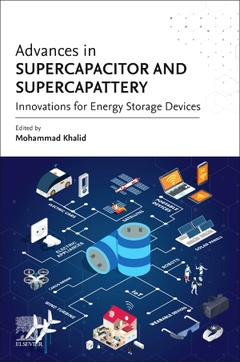Advances in Supercapacitor and Supercapattery Innovations in Energy Storage Devices

Advances in Supercapacitor and Supercapattery: Innovations in Energy Storage Devices provides a deep insight into energy storage systems and their applications. The first two chapters cover the detailed background, fundamental charge storage mechanism and the various types of supercapacitor. The third chapter give details about the hybrid device (Supercapattery) which comprises of battery and capacitive electrode. The main advantages of Supercapattery over batteries and supercapacitor are discussed in this chapter. The preceding three chapters cover the electrode materials used for supercapattery. The electrolyte is a major part that significantly contributes to the performance of the device. Therefore, different kinds of electrolytes and their suitability are discussed in chapter 6 and 7. The book concludes with a look at the potential applications of supercapattery, challenges and future prospective. This book is beneficial for research scientists, engineers and students who are interested in the latest developments and fundamentals of energy storage mechanism and clarifies the misleading concepts in this field.
Materials Scientists and Engineers in academia and R & D
Mechanical and Chemical Engineers.
Dr. Numan Arshid obtained his PhD in Physics with distinction from University of Malaya, Malaysia. His PhD research focused on the development of metal oxide nanostructures supported on carbon matrix for supercapacitor and electrochemical sensing applications. Additionally, he has worked on the preparation of solid/gel polymer electrolytes for electric double capacitors and novel electrode materials for hybrid supercapacitors. His research at the Graphene and Advanced 2D Materials Research Group (GAMRG) focuses on the preparation of 2D materials and their application for electrochemical energy storage.
Dr. A. Nirmala Grace is an Associate Professor at the Centre for Nanotechnology Research, VIT University, Vellore, India. She has more than 55 International Peer reviewed publications. Her current research group is working on various niche areas of nanotechnology like Hybrid Nanomaterials - Synthesis, Applications in Energy sector - Renewable Energy, Supercapacitors, Fuel cells, Batteries, Photoelectrocatalysis, H2 production and under Environmental, she is working on Photocatalysis and adsorbents for organic and Inorganic pollutant removal, CO2 conversion, and also on Sensor applications like gas and food sensors.
- Presents the three classes of energy storage devices and clarifies the difference between between pseudocapacitor and battery grade material
- Covers the synthesis strategies to enhance the overall performance of the supercapacitor device (including power density)
- Explains the energy storage mechanism based on the fundamental concept of physics and electrochemistry
Date de parution : 12-2020
Ouvrage de 412 p.
15x22.8 cm
Mots-clés :
?2D materials; Batteries and capacitors; Binary metal oxides; Carbon; Carbon materials; Carbonaceous materials; Chalcogenides; Chemical techniques; Cobalt oxide; Conducting polymer; Conducting polymers; Cyclic voltammetry; Dunn’s equation; Electric double-layer capacitor; Electrical double layer capacitors; Electrochemical; Electrochemical capacitors; Electrochemical energy storage; Electrodes for supercapacitors; Energy; Energy density; Energy storage; Energy storage device; Energy storage devices; Energy storage markets; Faradaic reactions; Flexible hydrogel electrolytes; Gel polymer electrolytes; Hybrid energy devices; Hybrid metal oxide; Hydrogels; Layered double hydroxide; MXene; Mechanical; Metal carbides; Metal oxides; Mxene; Nanocomposite; Nanosheets; Nanostructures; Nitrogen; Noble metal; Power density; Power density; Pseudo capacitor; Pseudo-capacitor; Pseudocapacitance; Pseudocapacitive; Ruthenium oxide; Solid polymer electrolytes; Specific capacitance; Supercabattery; Supercapacitor; Supercapacitors; Supercapattery; Ternary nanocomposite; Thermal; Transition metal



